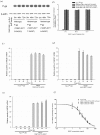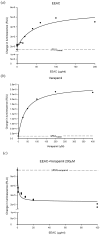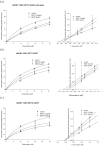The functional influences of common ABCB1 genetic variants on the inhibition of P-glycoprotein by Antrodia cinnamomea extracts
- PMID: 24586917
- PMCID: PMC3934917
- DOI: 10.1371/journal.pone.0089622
The functional influences of common ABCB1 genetic variants on the inhibition of P-glycoprotein by Antrodia cinnamomea extracts
Erratum in
- PLoS One. 2014;9(12):e116132
Retraction in
-
Retraction: The Functional Influences of Common ABCB1 Genetic Variants on the Inhibition of P-glycoprotein by Antrodia cinnamomea Extracts.PLoS One. 2022 Dec 13;17(12):e0279301. doi: 10.1371/journal.pone.0279301. eCollection 2022. PLoS One. 2022. PMID: 36512586 Free PMC article. No abstract available.
Abstract
Antrodia cinnamomea is a traditional healthy food that has been demonstrated to possess anti-inflammatory, antioxidative, and anticacer effects. The purpose of this study was to evaluate whether the ethanolic extract of A. cinnamomea (EEAC) can affect the efflux function of P-glycoprotein (P-gp) and the effect of ABCB1 genetic variants on the interaction between EEAC and P-gp. To investigate the mechanism of this interaction, Flp-In™-293 cells stably transfected with various genotypes of human P-gp were established and the expression of P-gp was confirmed by Western blot. The results of the rhodamine 123 efflux assay demonstrated that EEAC efficiently inhibited wild-type P-gp function at an IC50 concentration of 1.51 ± 0.08 µg/mL through non-competitive inhibition. The IC50 concentrations for variant-type 1236T-2677T-3435T P-gp and variant-type 1236T-2677A-3435T P-gp were 5.56 ± 0.49 µg/mL and 3.33±0.67 µg/mL, respectively. In addition, the inhibition kinetics of EEAC also changed to uncompetitive inhibition in variant-type 1236T-2677A-3435T P-gp. The ATPase assay revealed that EEAC was an ATPase stimulator and was capable of reducing verapamil-induced ATPase levels. These results indicate that EEAC may be a potent P-gp inhibitor and higher dosages may be required in subjects carrying variant-types P-gp. Further studies are required to translate this basic knowledge into clinical applications.
Conflict of interest statement
Figures





Similar articles
-
Functional impact of ABCB1 variants on interactions between P-glycoprotein and methadone.PLoS One. 2013;8(3):e59419. doi: 10.1371/journal.pone.0059419. Epub 2013 Mar 19. PLoS One. 2013. PMID: 23527191 Free PMC article.
-
Tenulin and isotenulin inhibit P-glycoprotein function and overcome multidrug resistance in cancer cells.Phytomedicine. 2019 Feb;53:252-262. doi: 10.1016/j.phymed.2018.09.008. Epub 2018 Sep 5. Phytomedicine. 2019. PMID: 30668405 Free PMC article.
-
A novel flavonoid from Fissistigma cupreonitens, 5‑hydroxy‑7,8‑dimethoxyflavanone, competitively inhibited the efflux function of human P-glycoprotein and reversed cancer multi-drug resistance.Phytomedicine. 2021 May;85:153528. doi: 10.1016/j.phymed.2021.153528. Epub 2021 Feb 25. Phytomedicine. 2021. PMID: 33735724
-
Influence of ABCB1 (1236C > T, 2677G > T and 3435C > T) polymorphisms on the transport ability of P-gp-mediated sunitinib in Caco-2 cell line.Xenobiotica. 2020 Mar;50(3):346-353. doi: 10.1080/00498254.2019.1610813. Epub 2019 May 15. Xenobiotica. 2020. PMID: 31023123
-
Suppression of Cell Growth, Migration and Drug Resistance by Ethanolic Extract of Antrodia cinnamomea in Human Lung Cancer A549 Cells and C57BL/6J Allograft Tumor Model.Int J Mol Sci. 2018 Mar 9;19(3):791. doi: 10.3390/ijms19030791. Int J Mol Sci. 2018. PMID: 29522490 Free PMC article.
Cited by
-
Antiandrogens Inhibit ABCB1 Efflux and ATPase Activity and Reverse Docetaxel Resistance in Advanced Prostate Cancer.Clin Cancer Res. 2015 Sep 15;21(18):4133-42. doi: 10.1158/1078-0432.CCR-15-0269. Epub 2015 May 20. Clin Cancer Res. 2015. PMID: 25995342 Free PMC article.
-
Single nucleotide polymorphisms of ABCB1 gene and response to etanercept treatment in patients with ankylosing spondylitis in a Chinese Han population.Medicine (Baltimore). 2017 Feb;96(5):e5929. doi: 10.1097/MD.0000000000005929. Medicine (Baltimore). 2017. PMID: 28151874 Free PMC article.
-
Taxifolin Resensitizes Multidrug Resistance Cancer Cells via Uncompetitive Inhibition of P-Glycoprotein Function.Molecules. 2018 Nov 22;23(12):3055. doi: 10.3390/molecules23123055. Molecules. 2018. PMID: 30469543 Free PMC article.
-
Zhankuic Acids A, B and C from Taiwanofungus Camphoratus Act as Cytotoxicity Enhancers by Regulating P-Glycoprotein in Multi-Drug Resistant Cancer Cells.Biomolecules. 2019 Nov 21;9(12):759. doi: 10.3390/biom9120759. Biomolecules. 2019. PMID: 31766413 Free PMC article.
-
Caffeic Acid Attenuates Multi-Drug Resistance in Cancer Cells by Inhibiting Efflux Function of Human P-glycoprotein.Molecules. 2020 Jan 7;25(2):247. doi: 10.3390/molecules25020247. Molecules. 2020. PMID: 31936160 Free PMC article.
References
-
- Lu MC, El-Shazly M, Wu TY, Du YC, Chang TT, et al. (2013) Recent research and development of Antrodia cinnamomea. Pharmacol Ther 139: 124–156. - PubMed
-
- Wang HC, Chu FH, Chien SC, Liao JW, Hsieh HW, et al. (2013) Establishment of the Metabolite Profile for an Antrodia cinnamomea Health Food Product and Investigation of Its Chemoprevention Activity. J Agric Food Chem 61: 8556–8564. - PubMed
-
- Jabir RS, Naidu R, Annuar MA, Ho GF, Munisamy M, et al. (2012) Pharmacogenetics of taxanes: impact of gene polymorphisms of drug transporters on pharmacokinetics and toxicity. Pharmacogenomics 13: 1979–1988. - PubMed
-
- Ueda K (2011) ABC proteins protect the human body and maintain optimal health. Biosci Biotechnol Biochem 75: 401–409. - PubMed
Publication types
MeSH terms
Substances
LinkOut - more resources
Full Text Sources
Other Literature Sources
Research Materials
Miscellaneous

